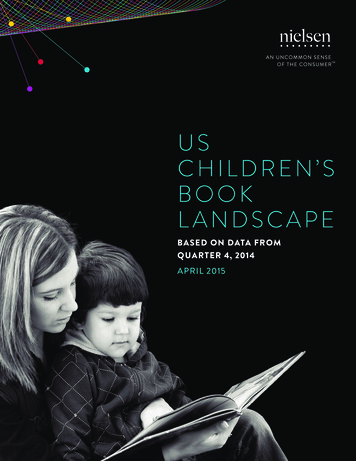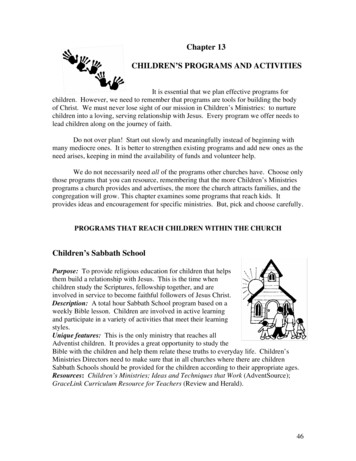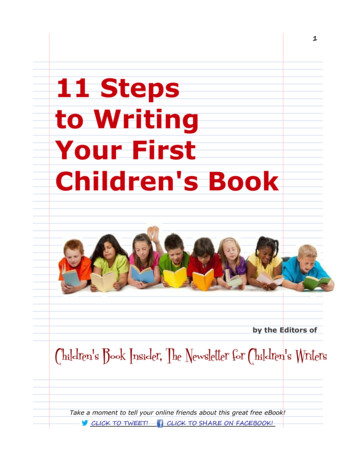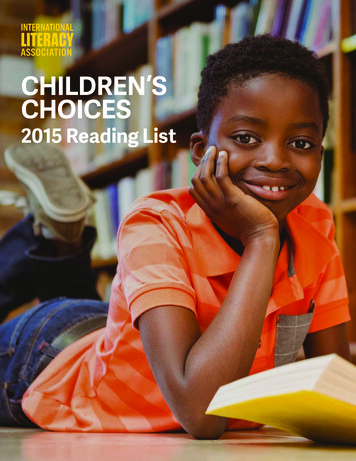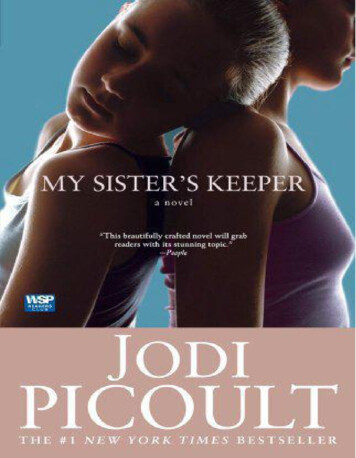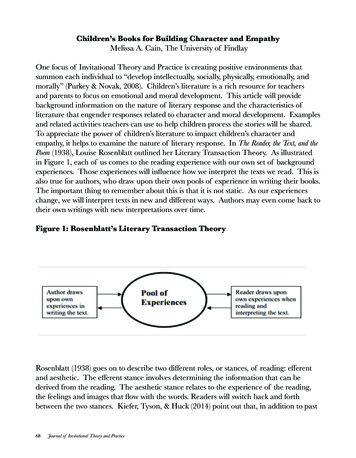
Transcription
Children’s Books for Building Character and EmpathyMelissa A. Cain, The University of FindlayOne focus of Invitational Theory and Practice is creating positive environments thatsummon each individual to “develop intellectually, socially, physically, emotionally, andmorally” (Purkey & Novak, 2008). Children’s literature is a rich resource for teachersand parents to focus on emotional and moral development. This article will providebackground information on the nature of literary response and the characteristics ofliterature that engender responses related to character and moral development. Examplesand related activities teachers can use to help children process the stories will be shared.To appreciate the power of children’s literature to impact children’s character andempathy, it helps to examine the nature of literary response. In The Reader, the Text, and thePoem (1938), Louise Rosenblatt outlined her Literary Transaction Theory. As illustratedin Figure 1, each of us comes to the reading experience with our own set of backgroundexperiences. Those experiences will influence how we interpret the texts we read. This isalso true for authors, who draw upon their own pools of experience in writing their books.The important thing to remember about this is that it is not static. As our experienceschange, we will interpret texts in new and different ways. Authors may even come back totheir own writings with new interpretations over time.Figure 1: Rosenblatt’s Literary Transaction TheoryRosenblatt (1938) goes on to describe two different roles, or stances, of reading: efferentand aesthetic. The efferent stance involves determining the information that can bederived from the reading. The aesthetic stance relates to the experience of the reading,the feelings and images that flow with the words. Readers will switch back and forthbetween the two stances. Kiefer, Tyson, & Huck (2014) point out that, in addition to past68Journal of Invitational Theory and Practice
experiences and stances, the developmental level of a child will also determine how he orshe responds to a particular book. Thus, it behooves teachers to take special care whenselecting books for their students.Kidd and Costano (2013) describe Theory of Mind as the human ability to understandour mental states (i.e., beliefs, intents, desires, pretenses, knowledge, etc.), and tounderstand that others also have mental states that may be different from our own. Theygo on to say that Theory of Mind (ToM) is one of the most amazing products of humanevolution because it allows successful navigation of complex social relationships and helpssupport the empathic responses that maintain them. Deficits or breakdowns in this setof abilities are marked by interpersonal difficulties, including the breakdown of positiveinterpersonal and intergroup relationships.Kidd and Costano’s experiments indicated that reading literary fiction temporarilyenhances Theory of Mind (Kidd & Costano, 2013). Literary fiction is a term principallyused for certain fictional works that hold literary merit. That is, they offer deliberatecommentary on larger social issues, political issues, or focus on the individual to exploresome part of the human condition (“Literary Fiction,” n.d.).What is it about literary fiction that enhances empathy? According to Kidd and Costano(2013), reading fiction increases self-reported empathy. It expands our knowledge ofothers’ lives, helping us recognize our similarity to them. It forces us to engage in mindreading and character construction, thus engendering empathy towards those characters.Although fiction may explicitly convey social values and reduce the strangeness of others,the observed relationship between familiarity with fiction and Theory of Mind may bedue to more subtle characteristics of the text (i.e., fiction may change how, not just what,people think about others). Miall and Kuiken (1994) contend that writers of literaryfiction use phonological, grammatical, and semantic stylistic devices like alliteration,metaphor, rhythm, and simile, to defamiliarize readers (i.e., unsettle their expectationsand challenge their thinking).Along the same lines, Barthes (1974 as cited by Kidd & Costano, 2013) distinguishesbetween writerly and readerly texts. Readerly texts—such as most popular genre fiction—are intended to entertain readers, who remain mostly passive. Writerly—or literary—texts engage their readers as creatively as if they were the writer him/herself. Bakhtin(1984 as cited by Kidd & Costano, 2013) described literary fiction as polyphonic, meaningthe authors tend to convey a “cacophony of voices.” (p. 378). Thus, readers of literaryfiction must contribute their own voice and enter into a vibrant discourse with the authorand his/her characters.Journal of Invitational Theory and Practice69
This discourse forces readers to fill in gaps and search for meanings among a spectrum ofpossibilities.How does this apply to books for children? While books for children are arguably lesscomplex than adult literary fiction, they can evoke Theory of Mind responses in youngreaders. Those that are well-written and comply with criteria for excellence for theirgenre and literary elements are most likely to evoke Theory of Mind responses. Forexample, a complex character in a middle grade or YA novel will appeal to children orteens on different levels, especially if that character is overcoming difficulties the readercan relate to. Even a simple text in a picture storybook can contain alliteration, rhythm,metaphor, simile, imagery, and word play to capture the imaginations of young readers.Piaget and Kohlberg studied the moral development of children and concluded thatas children grow in intellect and experience, they move away from the concept thatmorality is based upon adult authority and constraint and towards the idea that moralityis influenced by group cooperation and independent thinking (Kiefer, Tyson, & Huck,2014). This explains why books that fall out of favor with children tend to be those thatare the most didactic or preachy. While good books have good messages and themes,children do not like to be hit over the head with them. Like adults, they like to get themessage through relating to the characters.The idea that we should be exposing our children to literary fiction to develop theirTheory of Mind is difficult in a time when increasing emphasis is being placed onnonfiction reading. Figure 2 is a chart of the change in percentages of emphasis betweenfiction and nonfiction in the Ohio English Language Arts Standards, which are basedupon the national Common Core State Standards (CCSS).Figure 2. Increasing Focus on Nonfiction Text from OH ELA CCSS.Grade Literary Informational4 50% 50%8 45% 55%12 30% 70%70Journal of Invitational Theory and Practice
Literary NonfictionThe new emphasis on nonfiction is giving rise to a new kind of literary nonfiction thatfocuses on nonfiction topics but in writerly ways that inspire empathy. Here are a fewexamples:The Iridescence of Birds: A Book about Henri Matisse by Patricia MacLachlan, illustrated byHadley HooperThis beautiful book only contains two sentences, one ofwhich lasts for 16-page turns and describes the childhoodof Henri Matisse in a dreary northern French mill town;how his mother brought color to their lives through herpainted plates and the fruits, flowers, rugs, and fabricsshe brought into the house; and how young Matisseraised pigeons and was captivated by their iridescence.Hooper’s pictures, in slightly muted colors, look likewoodcuts and show how Matisse’s childhood experiencesinfluenced the designs of his adult work as a fine artist.Mumbet’s Declaration of Independence by Gretchen Woelfle, illustrated by Alix DelinoisMumbet was a slave owned by Colonel John Ashley, therichest man in Berkshire County, Massachusetts. Shehad no true name, but was called many by her abusivemistress. Her desire for freedom was her everydaycompanion. When the Colonies declared their freedom,Mumbet heard the new constitution’s promise that “Allmen are born free and equal” at a public meeting. Sheconvinced a young lawyer to sue Ashley for her freedom,arguing that the line meant everyone. In 1781, shewon. Soon after, slavery in Massachusetts was abolished,freeing all 5000 slaves in the state. This book puts a faceon the institution of slavery, which textbooks may not doas well.Journal of Invitational Theory and Practice71
Star Stuff: Carl Sagan and the Mysteries of the Cosmos by Stephanie Roth SissonIn the Milky Way galaxy, on the third planetfrom the sun, in a big city, in a small apartment,lived a curious boy who was fascinated withthe stars, loved science fiction, and had a vividimagination, all of which lead him to researchmore about the universe. Sagan and otherscientists sent out mechanical probes, includingVoyager I and II, and analyzed what theyfound. He used television to share the resultingknowledge, sparking the public’s imagination.Charming illustrations include a foldout thatgives a sense of the vastness of the night sky.This book provides children with an example ofsomeone who turned his childhood dreams intoa career.Activity—Literary NonfictionAfter reading the above three books and other literary nonfiction, children can list thebasic truths of the stories. They can compare these books to straight nonfiction aboutthe same topics and discuss how the authors use figurative language to make readers careabout the main characters. They may also be inspired to read more about their lives.Using Literature to Build CharacterTeachers can directly address building empathy by helping children understand positivecharacter traits through story. Here are some books that address Invitational Education’selements of trust, respect, care, optimism, and intentionality.72Journal of Invitational Theory and Practice
Trust and RespectMr. Peabody’s Apples by Madonna (Illustrated by Loren Long)Inspired by a 300-year-old Ukrainian story, but set in1949 in a tiny American town, this is the story of bighearted and much beloved Mr. Peabody, an elementaryschool teacher and Little League coach. When TommyTittlebottom sees Mr. Peabody take an apple withoutpaying for it, rumors of Mr. Peabody’s apparent theftcause children to stay away from Little League practice.A simple explanation puts the rumors to rest, but as Mr.Peabody points out, small talk can lead to big trouble.Activity—The Pillow Metaphor. Discuss the feather pillow metaphor in Mr. Peabody’sApples. The pillow represents Mr. Peabody’s integrity, truth, and reputation. The feathersrepresent gossip. When the pillow is torn, feathers fly out into the world. The lastillustration symbolizes the fact that a few feathers are still out, meaning not all people inHappville know Mr. Peabody is not a thief. The pillow is together, but the stitching showsit is still damaged.Responsibility and PerseveranceThe Most Magnificent Thing by Ashley SpiresA little girl and her canine assistant set out to make themost magnificent thing. But after much hard work, theend result is not what the girl had in mind. Frustrated, shequits. Her assistant suggests a long walk, and as they walk, itslowly becomes clear what the girl needs to do to succeed—persevere!Activity—Perseverance. Carol Dweck is the Stanford psychologist whose workaround achievement and success has helped us understand the power of having a growthmindset, rather than a fixed one (Glenn, 2010). A growth mindset allows us to learn fromtrial and error, recognizing the value in failure, as well as in hard work and dedication.Ask students to write about or discuss a time when they had to persevere to accomplish agoal.Journal of Invitational Theory and Practice73
CareNettie’s Trip South by Ann Turner (illustrated by Ronald Himler)In a letter to her friend, Nettie describes her trip to thepre-Civil War South. She remembers the sweet cedarsmell in the air and the sun pressing on her head. Butshe cannot forget Tabitha, a slave at the hotel who hasonly that one name, or the heaps of rags the slaves use forbeds. Most of all, she remembers the slave auction wherepeople were bought and sold like sacks of flour. Theseimages haunt Nettie and she cannot help but wonderwhat life as a slave would be like. Based upon the diaryof the author’s great-grandmother, this is a poignant andcompelling look at slavery.Activity—RAFT writing. Try RAFT writing to get students into the minds of thecharacters. RAFT stands for:R RoleA AudienceF FocusT TopicFor example, pretend you are Nettie and write a letter to the editor of your localnewspaper describing the inhumane conditions of slavery you witnessed and urgingchanges in the law.OptimismThe Lotus Seed by Sherry Garland (illustrated by Tatsuro Kiuchi)A young girl sees the last emperor of Vietnam cry on theday of his abdication. She takes a lotus seed from thepalace gardens as a remembrance and keeps it with herthrough the vicissitudes of war, flight, and emigration.One summer, a grandson steals it and plants it in a mudpool near the family’s American home. The followingspring, a lotus grows. The now elderly woman gives aseed to each of her grandchildren, passing on a traditionand her memories.74Journal of Invitational Theory and Practice
Activity—What is optimism? Discuss the following questions related to optimism:1.How was the lotus seed in the story a symbol of optimism?2.When was optimism illustrated in the story?3.Do immigrants come to America with a sense of optimism? In what ways?4.How does optimism help people who are experiencing difficulty?5.In what other situations is optimism helpful?Then, create a word web graphic organizer for optimism. Display the word in themiddle. Use the spokes to describe meanings, antonyms, synonyms, related phrases,examples, and a dictionary definition. Include personal connections to the word as well.IntentionalityThe Keeping Quilt by Patricia Polacco“We will make a quilt to help us always remember home,”Anna’s mother said. “It will be like having the family backhome in Russia dance around us at night. And so it was.”From a basket of old clothes, Anna’s babushka, UncleVladimir’s shirt, Aunt Havalah’s nightdress and an apron ofAunt Natasha’s become The Keeping Quilt, passed alongfrom mother to daughter for almost a century. For fourgenerations the quilt is a Sabbath tablecloth, a weddingcanopy, and a blanket that welcomes babies warmly into theworld. The quilt remains a symbol of their intentionality inpreserving their family love.Activity—Intentionality. Intentionality means, “done with purpose.” In The KeepingQuilt, a family uses the quilt to intentionally preserve their Russian past for futuregenerations. Give each student a quilt square in which to draw something that representsintentionality. The squares could contain covers or pictures from books that illustrateintentionality. Create a class quilt from the squares and display it.This is Patricia Polacco’s actual keeping quilt, now on displayat the Mazza Museum at The University of Findlay.Journal of Invitational Theory and Practice75
Using Literature to Build EmpathyCertain categories of books are likely to evoke empathy and improve Theory of Mind.Generally this is because the characters in the stories are well developed and the conflictsare relatable to readers. The categories include the following:1.Books representing people with disabilities.2.Books about bullying.3.Books representing people of different cultures.4.Books representing dystopian societies.5.Any work of fiction or fantasy in which the characters are multi-dimensional andevoke caring in readers.Understanding People with DisabilitiesA good place to start when looking for excellent booksabout people with disabilities is the Schneider FamilyAward books, indicated by the above medal on the cover.The Schneider Family Book Awards honor an author orillustrator for a book that embodies an artistic expressionof the disability experience for child and adolescentaudiences. The book “must portray some aspect of livingwith a disability, whether the disability is physical, mental,or emotional.” Each year three awards are given forbirth through grade school (age 0-10), middle school (age11-13) and teens (age 13-18) (See ook-award).Some examples across the age ranges follow:Wonder by R. J. PalacioAugust Pullman, age 10, has a facial difference that causedhim to be home schooled and avoid people. In his fifthgrade year, he goes to school for the first time. The beautyof this story is that it is told from the perspectives ofmultiple characters, allowing readers a much more complexunderstanding of Auggie. The following review by SarahJones (17 March 2012) demonstrates the power of this bookto evoke empathy:My 5th grader has craniofacial anomalies and I feel that this book could not have beenbetter written. Palacio caught Auggie’s voice and captured his challenges and strengths so76Journal of Invitational Theory and Practice
beautifully I still can’t believe that she doesn’t have a child who is living this life [ ] Manysmall moments [ ] struck me to the core—Auggie’s feelings about Halloween, the wayAuggie has an easier time when his classmates understand that there’s more to him thanhis face [ ] The most emotional moment [ ] came toward the end [ ] when his fathertells him that he loves the way Auggie looks [ ] exactly how my husband and I feel aboutour son. (para. 1-2)Activity—Precepts. Mr. Browne, Auggie’s English teacher, is fond of precepts, whichhe defines as “rules about really important things” or “words to live by.” For example, hisSeptember precept is, “When given the choice between being right or being kind, choosekind.” Wonder’s companion book, 365 Days of Wonder, lists these precepts.Try doing Mr. Browne’s precept assignment:1. Create a special section in your notebook.2. Each month, copy a selected precept into it.3. The class discusses the precept and what it means.4. At the end of the month, each student writes an essayabout what the precept means to him/her personally.5. Over the summer, Mr. Browne asks his students to writetheir own precept on a postcard and mail it to him.Out of My Mind by Sharon Draper“From the time I was little—maybe just a few months old—words were like liquid gifts,and I drank them like lemonade. I could almost taste them. They made my jumbledthoughts and feelings have substance. My parents have always blanketed me withconversation. They chattered and babbled. They verbalized and vocalized. My fathersang to me. My mother whispered her strength into my ear. Every word my parentsspoke to me or about me I absorbed and kept and remembered. All of them I havenever spoken one single word. I am almost eleven years old.”Journal of Invitational Theory and Practice77
Melody is the smartest kid in her school, but no one knows it because she can’t talk,walk, or write. Being stuck inside her head is making her go out of her mind—until shediscovers a tool that helps her speak for the first time. At last Melody has a voice!Activity—Writer’s craft. One focus of the Common Core State Standards forEnglish/Language Arts is the writer’s craft. One theme of Out of My Mind is the power ofwords in Melody’s life. Draper demonstrates her own exceptional power to use words toevoke images and convey empathy for Melody. Work in small groups to examine how shedoes this. Share. Next, do interactive editing on selected pieces of writing to enhance theword choice to convey more vivid images and evoke empathy for the characters.Piano Starts Here: The Young Art Tatum by Robert Andrew ParkerBad eyesight does not stop Art Tatum from learning toplay the family piano as a young boy. Art’s musical careergrows from playing professional shows in his hometownof Toledo, Ohio, to appearing with jazz bands across thecountry. Additional biographical information is in theendnotes.Kami and the Yaks by Andrea Stenn Stryer (illustrated by Burt Dodson)With a storm approaching, Kami—a Sherpa boy who isdeaf—finds the littlest of his family’s four yaks stuck in acrevice. Kami bravely rushes home, acts out the yak’s plightin sign, and then leads his father and brother to the rescue.Activity—Understanding personal disabilities. Kami and the Yaks and Piano StartsHere are for younger children and feature characters that overcome personal disabilitiesto accomplish something. Help children put themselves in the shoes of Art Tatum andKami by using blindfolds and earphones to simulate their disabilities.78Journal of Invitational Theory and Practice
Thank You, Mr. Faulker by Patricia PolaccoWhen Trisha starts school, she cannot wait to learn how toread, but the letters just get jumbled up. She hates beingdifferent and starts to believe her classmates when they callher a dummy. Then, she gets Mr. Falker as her fifth gradeteacher. When he discovers that she cannot read, he takesthe time to help her overcome her reading problems.Activity—Compassion. Mr. Faulker exhibits more than compassion for Trisha:he takes action to help her. Discuss actions we can take when we see someone who isstruggling.A Handbook for Dragon Slayers by Merrie HaskellReluctant Princess Tilda, sheltered due to her deformedfoot, longs to escape her destiny of quietly managingher kingdom . A thwarted kidnapping sends Tilda, herhandmaiden Judith, and Lord Parzifal on a dragon-huntingquest. Supported by friends and dragons, Tilda realizes herphysical limitations do not define her.Activity—Metaphor. Tilda ends up having an unusual relationship with the verydragons she set out to slay. Explore the metaphor of dragons together. What do theyrepresent? How was the dragon an appropriate metaphor for Tilda’s situation?Jerk California by Jonathan FriesenIsolated at school and tormented at home by his stepdad,Minnesota high school senior Sam Carrier feels definedby his Tourette syndrome. But long-distance running, hisdeceased father’s friend George, a special girl named Naomi,and a road trip to Jerk, California, change his perspective.This YA novel contains some strong language, but reallygets readers into Sam’s head as he struggles to keep himselfunder control.Journal of Invitational Theory and Practice79
The Fault in Our Stars by John GreenDespite the tumor-shrinking medical miracle that is buyingher a few more years, Hazel diagnosis has always beenterminal. But when she meets Augustus Waters at CancerKid Support Group, Hazel’s story takes on some new plottwists.Activity—Quotations. Insightful, bold, irreverent, and raw, The Fault in Our Starscontains many thought-provoking quotes worthy of discussion. Over 175 are posted atthis ult-in-our-stars.Understanding the Many Sides of BullyingBully by Laura Vaccaro SeegerBully does not have a kind word for any of his friends.When the other animals ask him to play, he responds with,“Chicken! Slow poke! You stink!” Seeger’s bold, graphicartwork pairs with spare but powerful words, making this taletender, funny, and thought provoking.Activity—The Power of Words. Discuss with children the words Bully used to insultthe other animals. Why do these words have the power to hurt us? What strategies canwe use to deflect such hurt? List these on a chart for future reference.Chrysanthemum by Kevin HenkesChrysanthemum thinks her name is absolutely perfect—untilher first day of school. “You’re named after a flower!” teasesVictoria. “Let’s smell her,” says Jo. Chrysanthemum wilts.Suddenly her name seems not so special.80Journal of Invitational Theory and Practice
Activity—All Kinds of Names. Ask the children to share the stories of how they gottheir names. Bring in a baby name book and look up the meaning of the names of thechildren in the class. The variety should lead to interest, not teasing.Bully by Patrica PolaccoLyla finds a great friend in Jamie on her first day of school,but when Lyla makes the cheerleading squad and a cliqueof popular girls invites her to join them, Jamie is left behind.Lyla knows bullying when she sees it, though, and whenshe sees the girls viciously teasing classmates on Facebook,including Jamie, she is smart enough to get out. But no onedumps these girls: now they are out for revenge.Activity—Cyber bullying. This is a good book to use to promote discussion cyberbullying. Help children develop positive strategies for dealing with social media. Chartthese for future reference.The Bully Book by Eric Kahn GaleEric Haskins coasted through elementary school withoutattracting undue attention. But this year he is the Grunt,the kid everyone in sixth grade hates. Unsure of what hedid wrong, Eric becomes obsessed with getting his hands onthe mythic Bully Book, which will supposedly tell him why hehas been designated the Grunt. Eric keeps a journal, pagesof which are intermixed with pages from The Bully Book.Reading the two together highlights how enigmatic bullyingis for the child on the receiving end of a set of unwrittenrules. The fact that The Bully Book writes those rules downadds a conspiratorial menace, reinforcing the insidiousnature of bullying.Journal of Invitational Theory and Practice81
By the Time You Read This, I’ll Be Dead by Julie Anne PetersAfter a lifetime of being bullied, Daelyn has had enough.She has tried to kill herself before and is determined to tryagain. Though her parents try their best to protect her,she finds a website for completers and blogs on its forums,sharing her personal history. The only person at school whotries to interact with her is a boy named Santana. Eventhough she treats him poorly, he won’t leave her alone,causing her to wonder whether it is not too late to let peopleinto her life after all. Peters shines a light on what mightmake a teenager want to commit suicide and what mightbring her back from the edge.Tease by Amanda MacielEmma Putnam is dead and Sara Wharton, her best friend,and three other classmates have been criminally chargedfor the bullying and harassment that led to her shockingsuicide. Now Sara is the ostracized one—guilty accordingto the media, the community, and her peers. Betweenmeetings with lawyers and a court-recommended therapist,Sara reflects on the events that lead to the tragedy and herown undeniable role in it. Somehow she must find a wayforward, even as she feels her life is over.Stargirl by Jerry SpinelliFrom the day she arrives at quiet Mica High in a burstof color and sound, nonconformist Stargirl is one of thepopular ones. Her smile captures the heart of Leo Borlockand she sparks school-spirit with just one cheer. Everyone atMica High is enchanted with her—until they decide they arenot. Suddenly Stargirl is shunned for everything that madeher special to begin with. Leo, desperate with love for herand panicked by her reversal in status, urges her to becomenormal—the very thing that could destroy her.Activity—The many sides of bullying. Use the four previous books and others like82Journal of Invitational Theory and Practice
them to set the stage for critical thinking about the many sides of bullying and its diversevictims. How is social media a double-edged sword? How can our attitudes toward itprotect us? Try doing this in literature circles, where the students choose their bookand participate in chapter-by-chapter discussion related to it as they read. Then cometogether as a whole group to share.Understanding People of Other CulturesThere are several ways literature can raise cultural awareness. First, reading the folkloreof a country or culture enlightens readers as to its traditional beliefs, customs, and storiesthat were originally passed through the generations by word of mouth. Some booksillustrate or celebrate culture. These may be fiction or nonfiction and typically have moremodern settings than traditional tales, which tend to be set during once upon a time.Such books often show universal aspects of being human, despite cultural differences.Still other stories have conflicts that are a result of differences in culture and beliefs.Some of these deal directly with racism. Some are transplanted culture stories in whicha character suddenly has to cope with living in an unfamiliar culture. Others show whathappens when cultures collide. These may be stories of wars, feuds, or misunderstandingsrelated to cultural differences.Folklore.It is said that there is a Cinderella story for every culture in the world. These coversillustrate some from Mexico, Egypt, China, and Native America.Activity—Exploring multiple cultures through folklore. Gather as manydifferent versions of Cinderella, or another folktale, as you can find. Share these withyour students. Discuss the similarities and differences among the versions. How do thesebooks convey the cultures they represent? Chart this.Journal of Invitational Theory and Practice83
Books illustrating culture and cultural universals.Dumpling Soup by Jama Kim RattaginMarisa gets to help make dumplings this year to celebratethe New Year. But she worries about whether anyone willeat her funny-looking dumplings. Set in the HawaiianIslands, this story celebrates a joyful mix of food, customs,and languages from many cultures—all in Marissa’sextended family.Activity—Cultural sharing. The foods prepared by the family in Dumpling Soupreflect the mix of cultures in their family. Host an international food day in your schoolor classroom, asking students to bring dishes to share that represent their culturalheritage.Abuela by Arthur DorrosWhile riding on a bus through Manhattan with Abuela, herSpanish-speaking grandmother, a little girl imagines thatthey are carried up into the sky and fly over the sights ofNew York City. This evocative story demonstrates the lovingbond between child and grandparent.Activity—Grandparent show and tell. Invite grandparents to school. Children canintroduce them and their backgrounds, sharing special names
Children’s Books for Building Character and Empathy Melissa A. Cain, The University of Findlay One focus of Invitational Theory and Practice is creating positive environments that summon each individual to “develop intellectually, socially, physical



